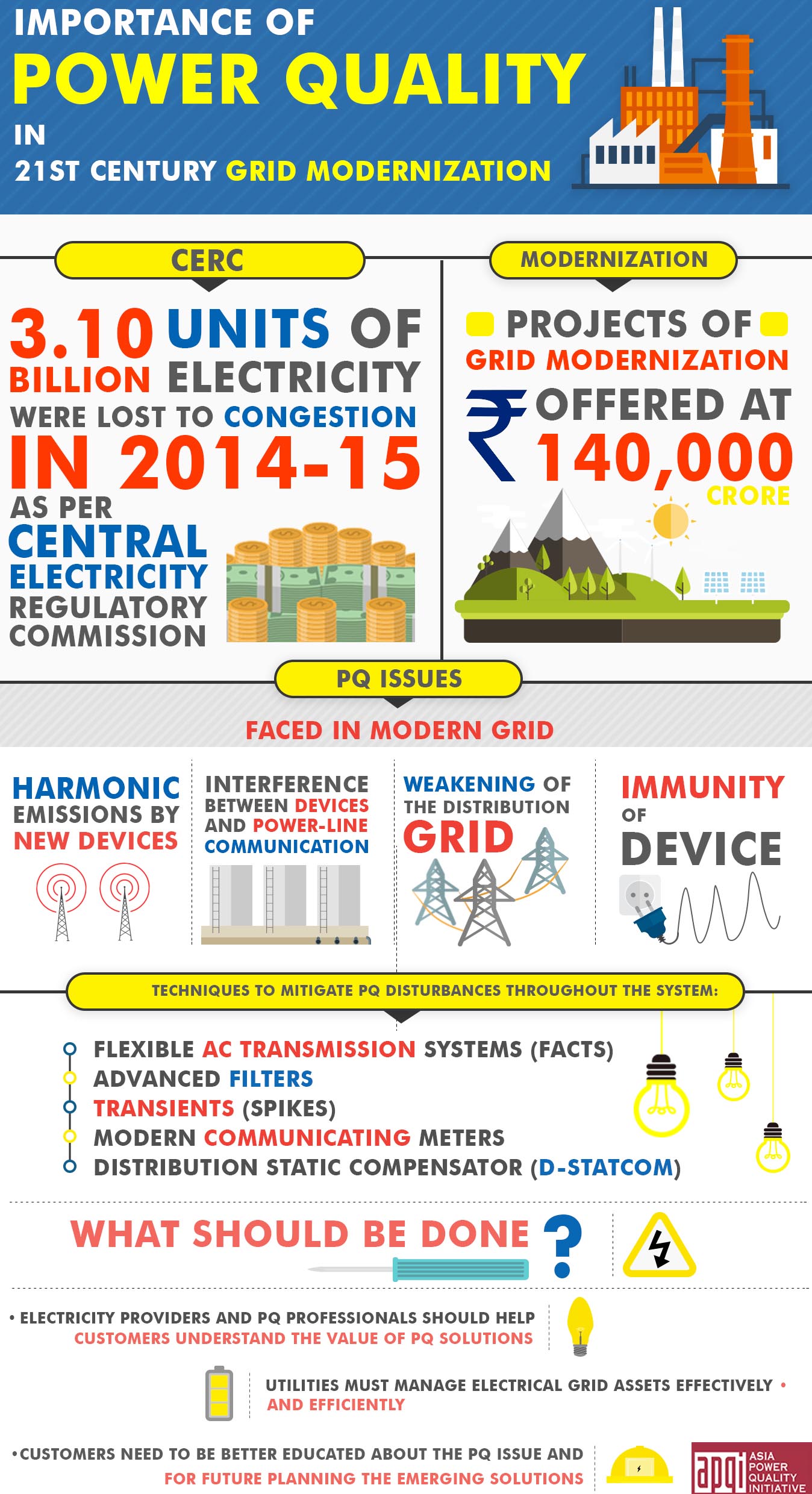Published On: Nov 03, 2016
Technology is changing, the energy industry is changing, and today’s energy customer is changing. There is a need to transform the existing grid into a next-generation intelligent grid that will address the evolving needs of end customers, and at the same time continue to provide safe, reliable, quality, and affordable electricity.
India’s transmission grid network has been a bottleneck in the power sector as its capacity is lagging power generation capacity. Transmission congestion has become one of the serious issues with de-licensing of generation and the recent spurt of renewable energy, resulting in situations where demand could not be met even as supply was available on the grid. Another challenge that the sector has faced since it’s opening up is repeated barrier to open access citing inadequacy of grid network. According to data by Central Electricity Regulatory Commission (CERC), 3.10 billion units of electricity on power exchanges were lost to congestion in 2014-15. Therefore, there is a greater need for investments, especially at the state-level and grid-scale, to bring competition in the sector through open access, public-private partnership (PPP) model, etc. Various states are offering large projects of grid modernization through PPP model and the opportunities in these states alone is seen at Rs 140,000 crore.
On the other hand, we find that India’s 21st century electricity distribution grid is becoming smarter with the help of advanced & digital technologies, where consumption and efficiency can work together to generate savings & benefits. However, in want of lack of continuing investment in distribution infrastructure in last two decades the health of grid is not up to mark affecting quality delivery of power to all on 24X7 basis. It has also become vulnerable with renewable energy integration and fluctuating voltages determined by customer load & decentralized generation. Further, in today’s economy, digital devices have become the engines of most industries, thereby putting an additional responsibility on the grid network to maintain the power quality. This blog discusses the importance of power quality management and monitoring in the paradigm of the 21st century Grid Modernization efforts to provide a better and sustainable delivery of power to all.
SENSITIVITY TO POWER QUALITY IN GROWING MODERN GRID INFRASTRUCTURE
The next generation grid looks very different from the grid of today. Power will come from multiple sources, flow in multiple directions, and be more environmentally friendly. Yet, the variability and intermittency of renewable energy sources both at the distributed and centralized levels will create voltage and power quality issues. Due to these issues, grid modernization will also be seriously impacted. Some of the key PQ issues in modern grid are:
- Harmonic emissions by new devices: With modern/smart grids, it is expected growth both in the generation at lower voltage levels (distributed generation) and in new types of consumption (for e.g., charging stations for electric vehicles, expanded high-speed railways, etc.). Some of these new types of consumption will emit power-quality disturbances, for example, harmonic emission.
- Interference between devices and power-line communication:.Modern grids will depend on a large extent on the ability to communicate between devices, customers, distributed generators, and the grid operator. Many types of communication channels are possible, however, power-line communication might seem an obvious choice due to its easy availability. But choosing power-line communication could introduce new disturbances in the power system, resulting in a poor power quality.
- Weakening of the distribution grid: The increased use of distributed generation and of large renewables will result in a reduction of the amount of conventional generation connected to the transmission system. The fault level will consequently be reduced, and power quality disturbances will spread further.
- Immunity of device: Simultaneous tripping of many distributed generators due to a voltage-quality disturbance (like a voltage dip) is also an issue. As a smart grid attempts to maintain a balance between generation and consumption, mass tripping of consumption could have similar adverse consequences.
The most serious consequence of poor power quality is not only the physical network that may be damaged but the quantum of lost data, reduced productivity, costly downtime and poor product quality. Hence, power quality monitoring, together with the proper information and advanced techniques, will become the backbone of a fully implemented modern grid.
IMPORTANCE AND NEED OF PQ IMPROVEMENT IN GRID MODERNIZATION ERA
|
Today’s global competitiveness demands fault-free operation of the digital devices that power the productivity of our 21st century economy. The modern grid must apply power quality solutions wherever they are needed—where the power begins, where it gets distributed, or where it ends. Non-linear loads connected to the complex nature of today’s grid give rise to various PQ issues like Voltage Sag/Swells, Harmonics, Transients, Voltage Imbalance, etc. Its impact varies across consumers, whether industrial, commercial, or residential categories. For e.g. at one end of the spectrum, an integrated circuit manufacturer will incur very large losses if a PQ event shuts down the process, and at the other end, a homeowner may be merely affected when a DVD player shuts down.
|
- Distribution Static Compensator (D-STATCOM), On-Load Tap Changer (OLTC) transformers, etc. are other widely used devices to regulate and maintain voltage regulation in distribution networks.
As a modern grid will have two-way communication, a significant role in mitigating PQ issues is contributed by the customer as well. The fact is that power quality isn’t on the radar screens of executives who have not experienced problems directly. For them, power quality is of little importance. Therefore, it’s up to electricity providers and PQ professionals to help customers understand the value of power quality solutions from the perspective of their business needs. They must market power quality solutions in a clear manner, explaining how implementing it will increase productivity and reduce costs. Hence, customers need to be better educated about the PQ issue and for future planning the emerging solutions should be widely publicized.
Further, in today’s rapidly expanding and evolving electrical power system environment, utilities must manage electrical grid assets effectively and efficiently. PQ improvement requires utilities to have a relook at their strategies for making appropriate investments in the network to increase load capacity and extend electrical equipment life. It is one of the key strategic areas in today’s power business and will be a differentiator in the fast changing utility business model, where it’s no more about 24×7 power supplies alone.
CONCLUSION
Almost half of PQ disturbances originate in the transmission and distribution components of the electrical power system. As sensitive electronic loads represent an increasing portion of the total power system load, power quality is of growing importance in the 21st century. Hence, for grid modernization projects to be successful, a bottoms up approach is important to address power quality and probably is the only approach to sustain the power pyramid in the era of non-conventional generation.
In addition, a systemic approach needs to be aligned between various stakeholders like utilities, regulators, service providers and standards bodies in attaining improved PQ environment in the modernized grids.
REFERENCES
- Provides power quality for the digital economy by National Energy Technology Laboratory, October 2009.
- Grid Modernization Distribution System Concept of Operations by Southern California EDISON, January 2016.
- A Modern, Integrated Power Grid: The Perfect Setting for Doing More and Using Less by Alliance to save energy, 14 Sep 2016.
- Research on the Characteristics of a Modern Grid: Power Quality for the Digital Economy by Bruce Renz, December 17, 2008.
- Power Quality Issues and Need of Intelligent PQ Monitoring in the Smart Grid Environment by S. H. Laskar and Mohibullah, September 2012.
- Smart Grid Challenges in India by Avishek Ghosal, March 30, 2015.
- An overview of power quality issues in Smart grid by E. Prathibha, A.Manjunath, International Journal of Innovative Research in Advanced Engineering (IJIRAE), November 2014.
- Modern Grid Benefits by National Energy Technology Laboratory, August 2007.








